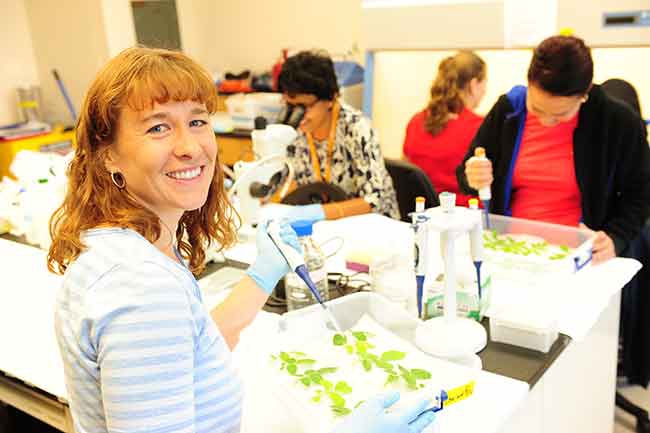
Features
Biocontrols
Inputs
Biopesticides: New Wave of Control
So what are they? The term encompasses several classes which include micro-organisms, naturally-occurring substances, and substances produced by plants.
August 13, 2015 By Dr. Anissa Poleatewich
 “Biopesticides are not silver bullets and should be used within an IPM system.”
“Biopesticides are not silver bullets and should be used within an IPM system.” Sept. 2015 – In virtually all areas of horticulture today, there is a place for both biopesticides and traditional agrochemicals. Maximum benefits can be achieved through the integration of the two strategies in an approach known as Integrated Pest Management (IPM).
IPM is an effective and environmentally sensitive approach to pest management that relies on a combination of cultural, biological and chemical means to control pests.
Most people in agriculture understand the definition of a traditional crop protectant. So what exactly are biopesticides? The term encompasses several classes which include micro-organisms, naturally occurring substances, and substances produced by plants.
Biopesticides are the fastest growing segment of the crop protection market.
According to a Meister Media special report, the biopesticide market increased over 200 per cent from 2007 to 2012. Growth has been driven by the need to reduce chemical pesticide residues, stricter import and supermarket standards, the shorter pre-harvest and re-entry intervals assigned to biopesticides, and a push for new and innovative techniques for managing resistance.
Regulations in the European Union have also provided significant impetus to incorporate more biopesticides into crop protection programs. Advances in product development, research and extension also help meet these needs.
The biopesticide industry has evolved significantly over the past 30 years with innovations in manufacturing, formulation, and application technologies, and investment in sound technical support. The biopesticide market has also moved from solely being the domain of small companies to a leading investment area for large agrochemical companies such as Syngenta, BASF, Monsanto, Bayer Crop Science and DuPont.
So why use biopesticides and how can they work for you?
Biopesticides have no chemical residues, typically have minimal impact on beneficial non-target organisms (such as predators, parasitoids and pollinators), are not prone to resistance, are safer for workers and the environment, enhance crop yields and provide harvest flexibility.
Biopesticides have no Maximum Residue Limit (MRL) and no re-entry or pre-harvest interval. This allows growers to access new markets, particularly in the EU where there are strict residue regulations. Additionally, growers can apply a biopesticide up until the day of harvest, providing protection in the absence of a traditional chemical.
In the past, biopesticides were perceived as difficult to use and not reliable. Getting the maximum benefit out of them requires knowledge of your crop, the pest or pathogen biology and how the product works.
It is essential that a microbial pesticide be applied at the right time and place. It is also important for growers to work with registered products and established suppliers offering strong technical support programs.
There is a learning curve for those just starting out, but biopesticides can deliver significant value when used properly, and can be readily integrated with other crop management tactics. Biopesticides are best used in a preventive and suppressive manner rather than curative, which requires a proactive approach to crop health.
One of the misnomers of biopesticides is that they are used only for organic production. However, according to the Biopesticide Industry Alliance (BPIA) about 95 per cent of sales are in conventional systems for use in conjunction with traditional chemistries. Rotation with biopesticides can promote crop health while prolonging the life of traditional chemistries by exposing pests and pathogens to different modes of action which delays development of resistance.
It is important to understand that biopesticides are not silver bullets and should be used within an IPM system. In combination with other strategies, measureable improvements in pest control, water management and crop yields are noted.
ABOUT VINELAND RESEARCH AND INNOVATION CENTRE
Located in the Niagara Region, the Vineland Research and Innovation Centre (Vineland) is a world-class research centre dedicated to horticultural science and innovation. With a highly skilled research team, oversight from an independent board of directors, engagement from an international science advisory committee and collaboration with more than 160 global partners including a stakeholder advisory committee, Vineland’s goal is to enhance Canadian growers’ commercial success through results-oriented innovation.
Vineland is an independent, not-for-profit organization, funded in part by Growing Forward 2, a federal-provincial-territorial initiative.
Vineland’s research program – The Right Tools: Integrating Biocontrol Systems for Impact and Results – is developing effective biocontrol strategies for the control of insect pests and plant pathogens in greenhouse and nursery settings, and providing growers with best management practices integrating conventional and novel approaches.
For more information on Vineland and its research programs, please visit vinelandresearch.com, VinelandResearch on Facebook, or follow @vinelandrsrch on Twitter.
Dr. Anissa Poleatewich is a research scientist, plant pathology, at Vineland Research and Innovation Centre.
Print this page